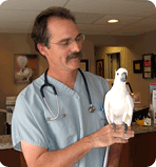Weight fluctuations in an Amazon parrot

I have a 28yr old Red Lored Amazon, could be wild caught we don’t know for sure. His weight fluctuates as much as 30-40g per year. Is this normal? He is currently coming off of being hormonal and molting although not heavily and his appetite is not as good as previous times of the year. I realize coming out of breeding season that his body is telling him not to eat as much, but the vet feels his ideal weight is 500g and he is currently at 470-485g depending on what he ate the day before.
I have read but don’t remember where, that wild caught birds tend to be more on the lean side in captivity than their handfed counterparts, is this true? He has been at this weight before but I don’t remember if it was after breeding season and during a molt. He was just at the vet 2 weeks ago for his yearly checkup and everything was fine, phosphorous was slightly low but everything else was in normal range. 30g grams just seems like a big weight shift to me and I’m concerned. He is acting normal and playing and preening as usual so maybe I’m worried for nothing. Just wondering if this is part of the normal cycle for amazons, my other two birds, nanday and lovebird do not shift weight like this during the year? Thanks so much.
Janna

Fluctuation of more than 5% of body weight is not typical. Most often, gains in weight will be related to increases in muscle mass (improved physical conditioning) or fat.
Realistically, your bird’s optimal weight would be that weight where the bird has good and even pectoral muscle mass present, and no apparent subcutaneous fat present at the abdomen or lateral flank skin regions. If you were to dampen the feathers in this area with isopropyl alcohol, you can see the skin very clearly for evaluaton.
Breeding season and hormonal cyclicity for the most part in parrots is strongly influenced by the environment, most of which we have control over. Dietary caloric intake is a strong reproductive stimulus for many parrots - and I am a bit suspicious that the hormonal cyclicity in part is being influenced in your bird by total calories being consumed or made available per day.
Most of the Red Lored Amazons in our database that were not obese seemed to range from 390-450 grams or so, and most of the birds that were 500 grams or over had the clinical observation of fat present and a diagnosis to some degree of obesity noted. Although your individual bird may be larger than most, and may actually be just a big guy - I am a bit suspicious that he may be overweight.

































